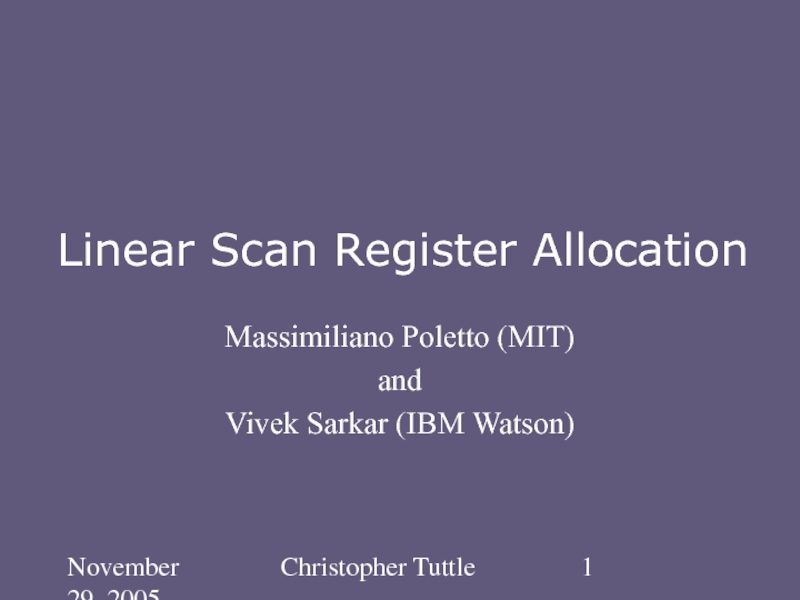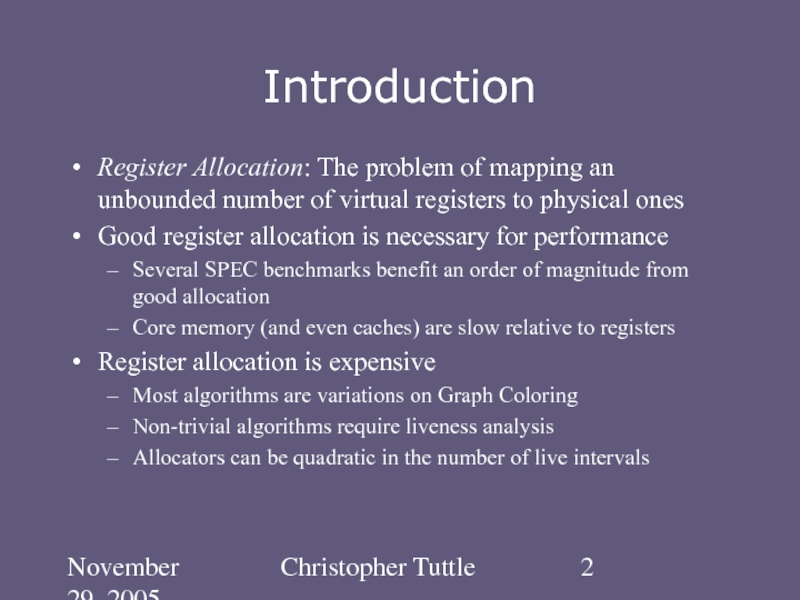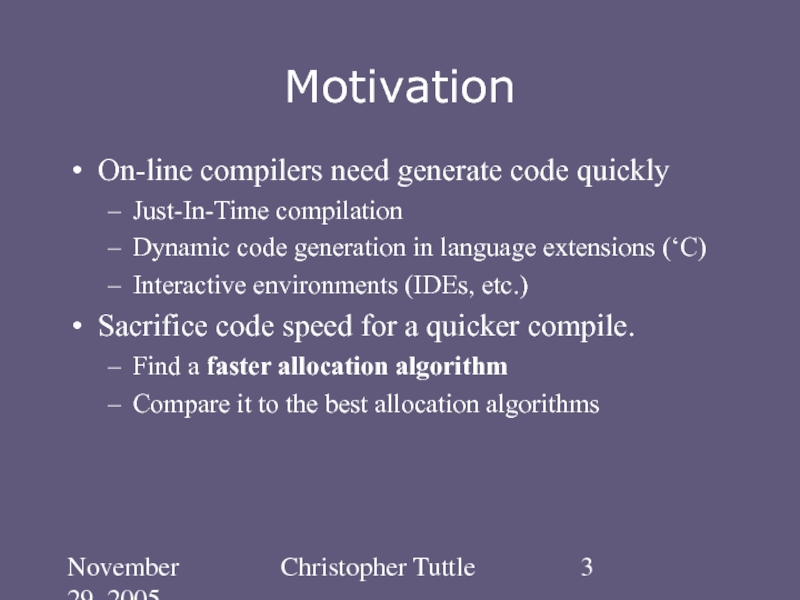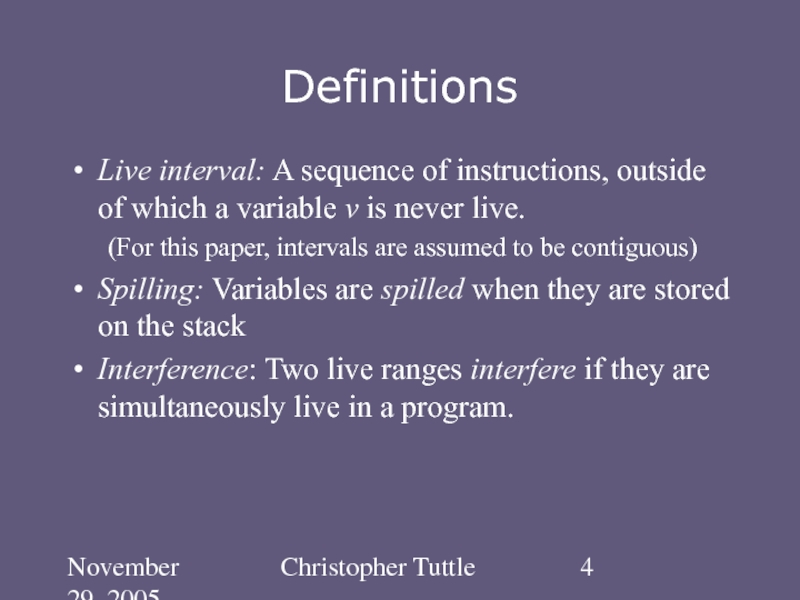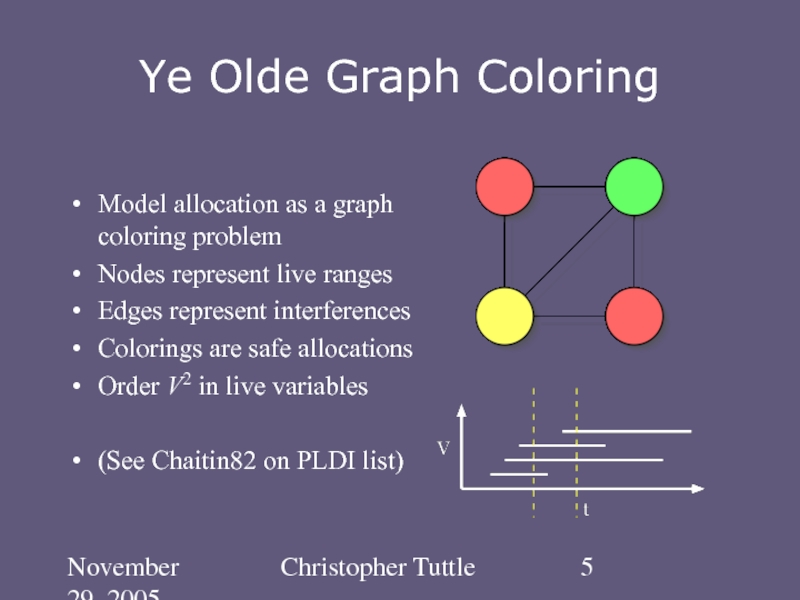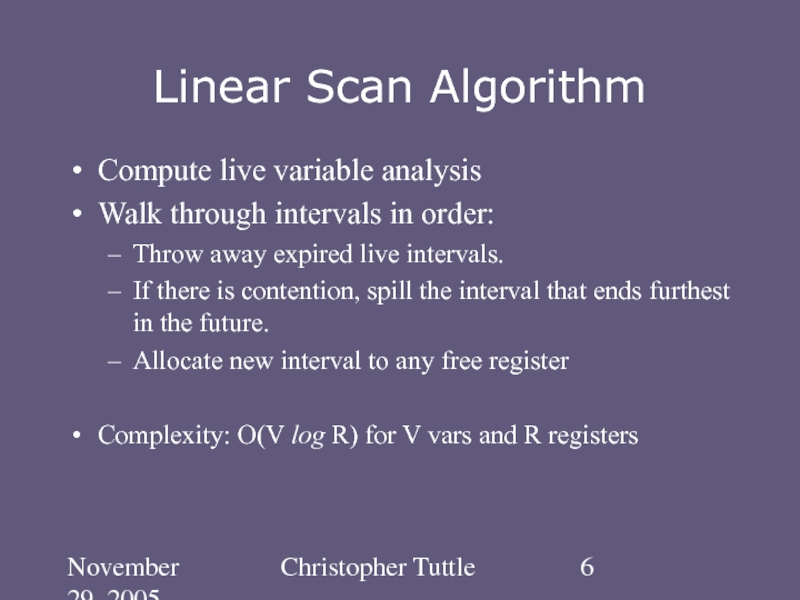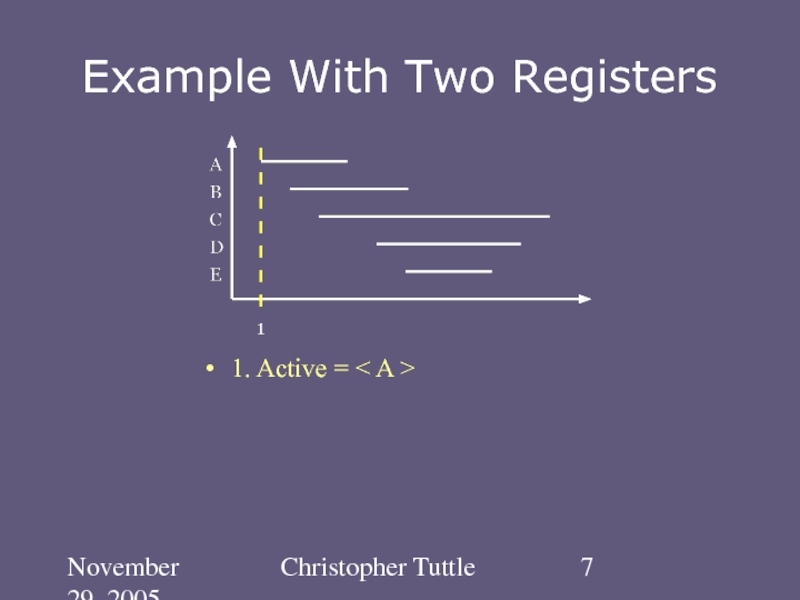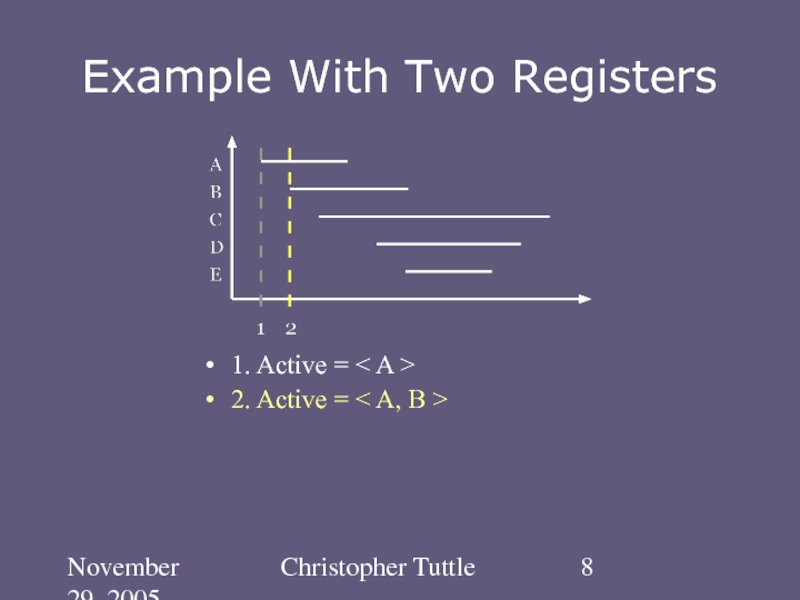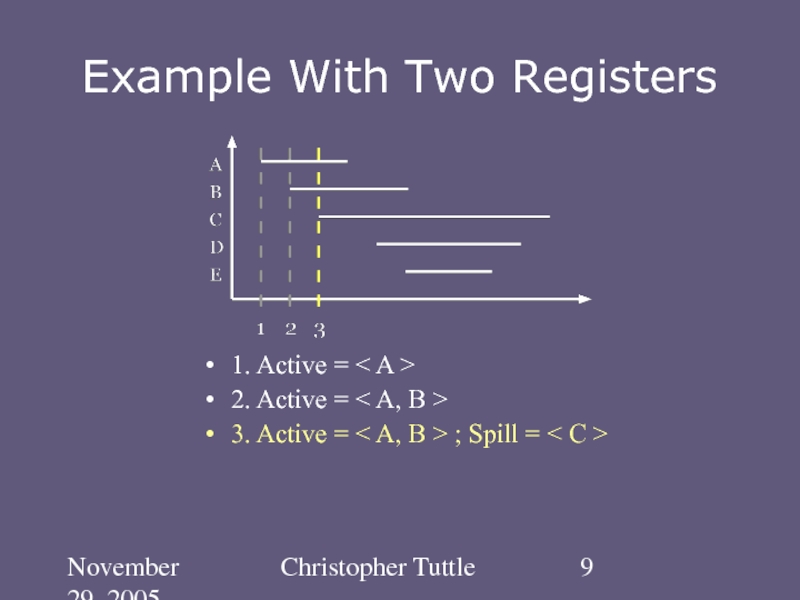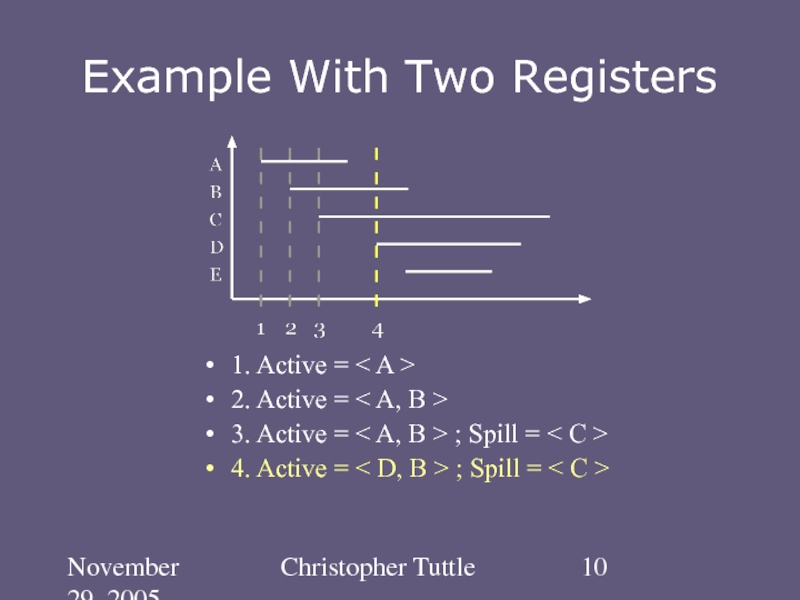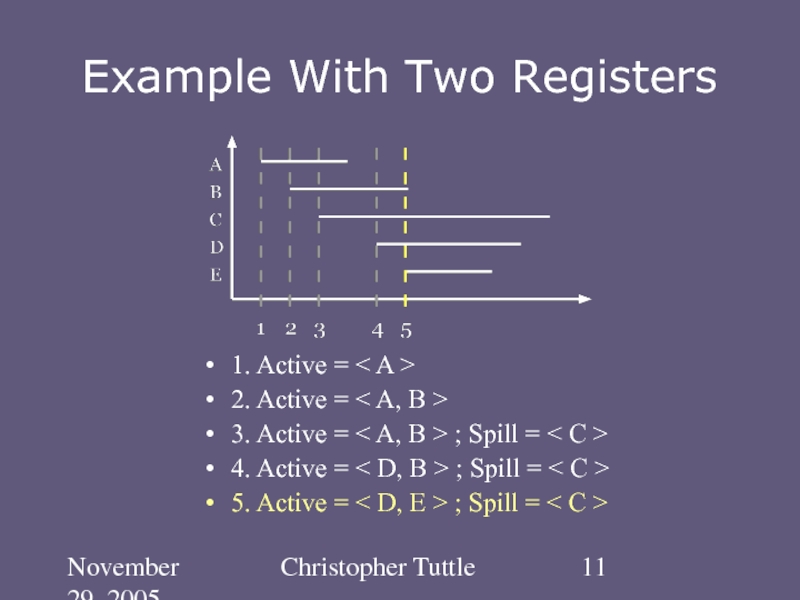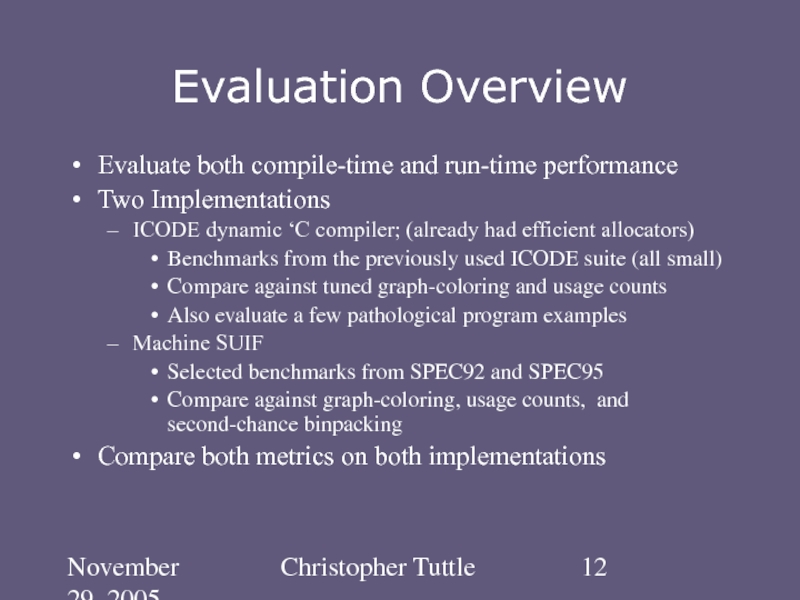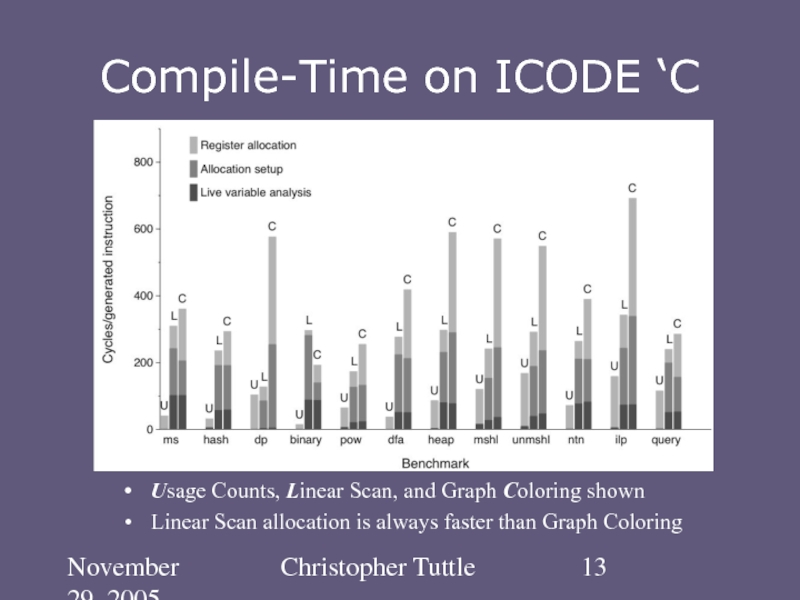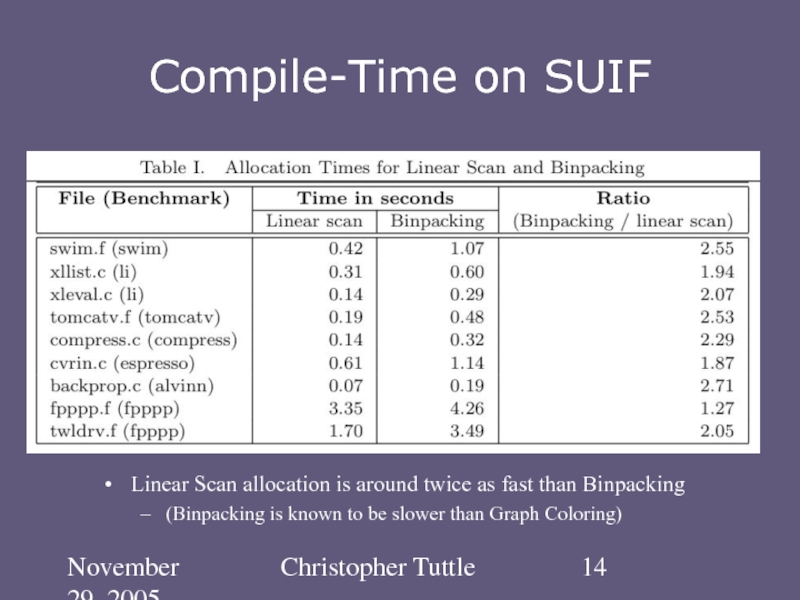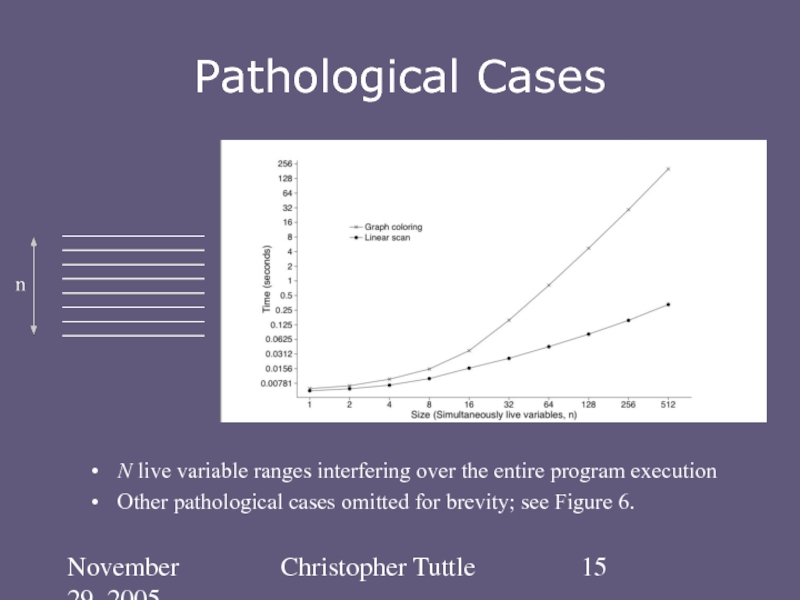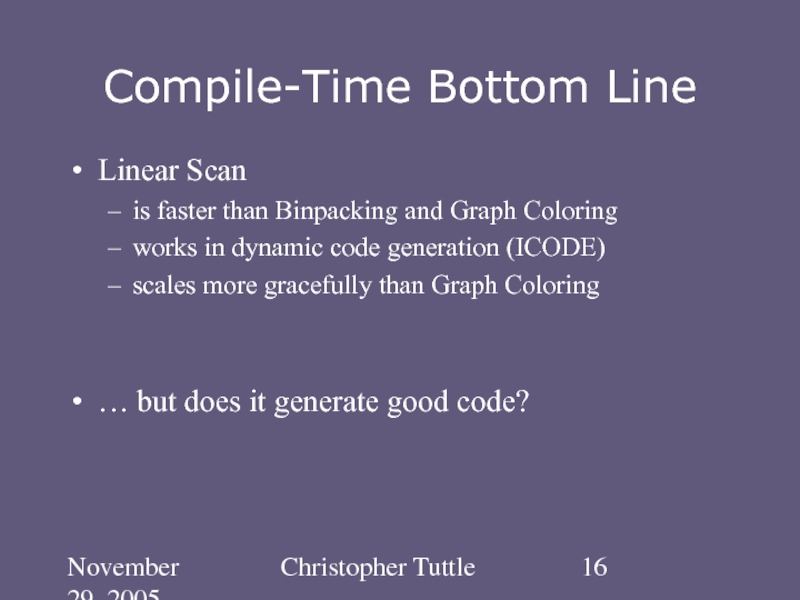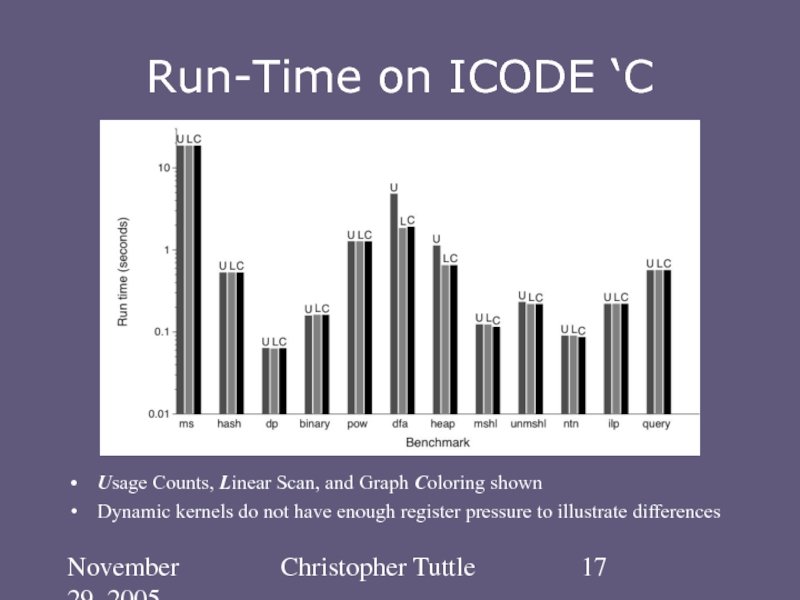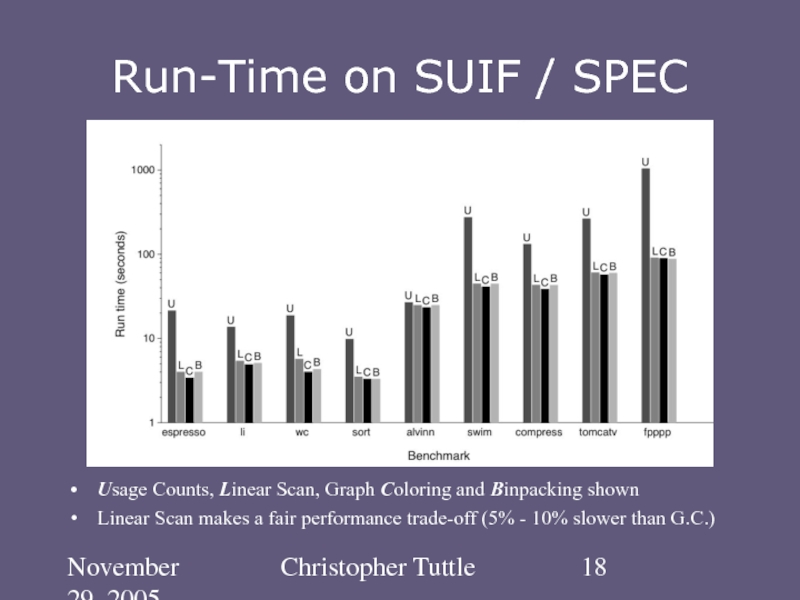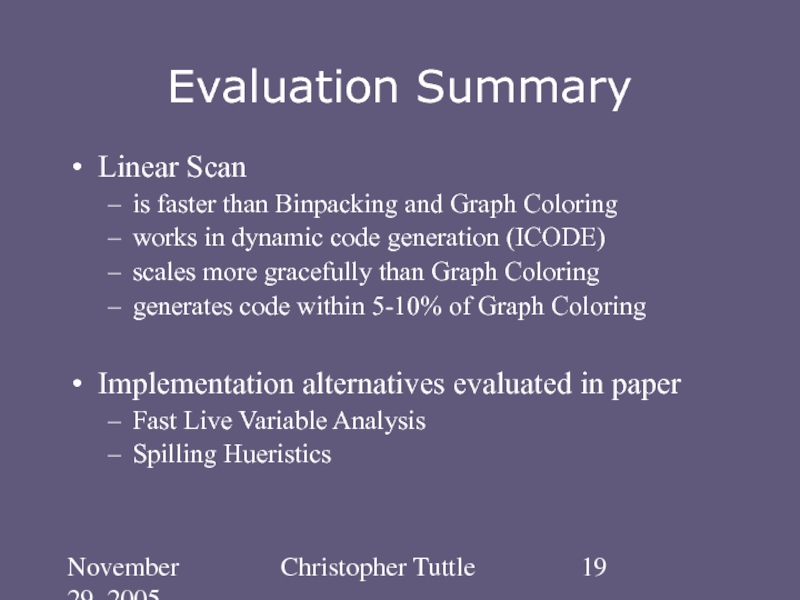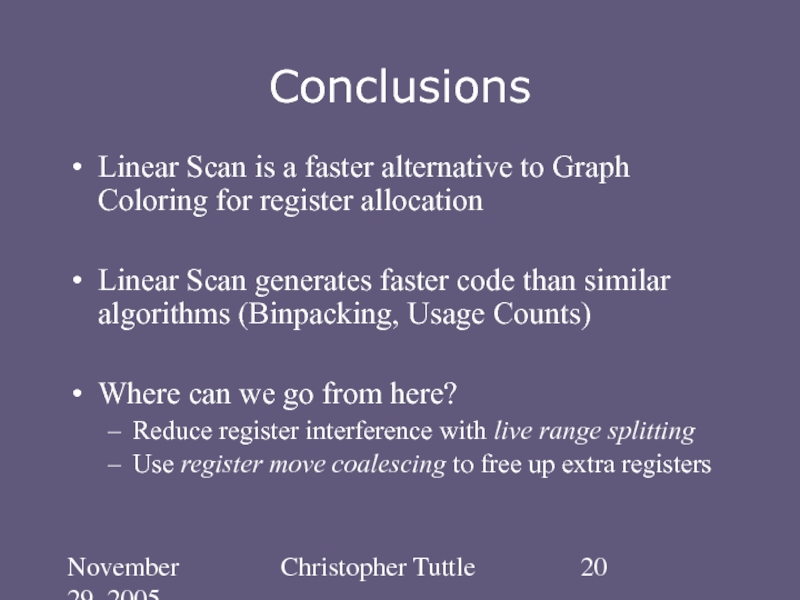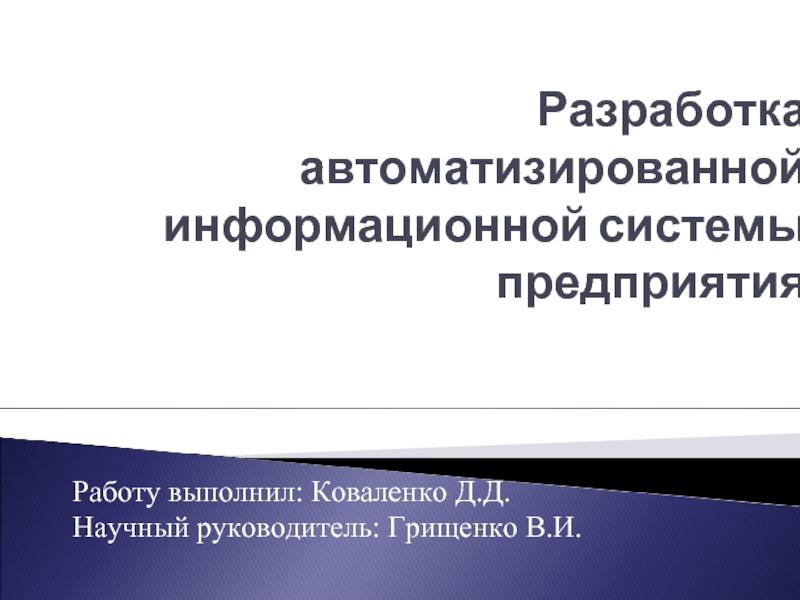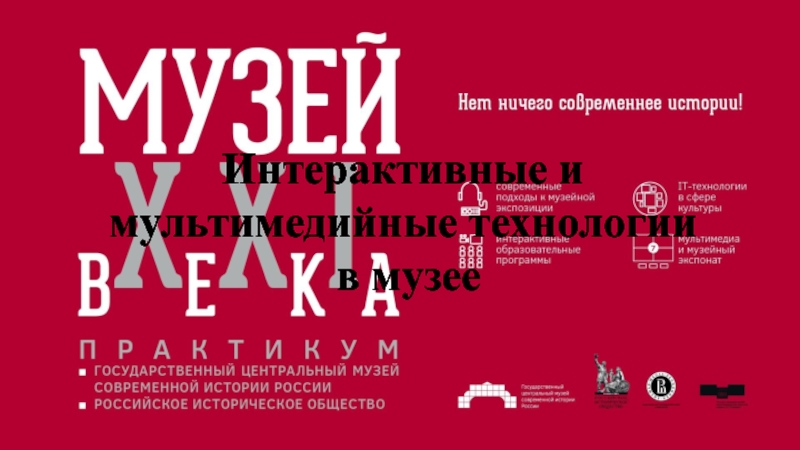(IBM Watson)
- Главная
- Разное
- Дизайн
- Бизнес и предпринимательство
- Аналитика
- Образование
- Развлечения
- Красота и здоровье
- Финансы
- Государство
- Путешествия
- Спорт
- Недвижимость
- Армия
- Графика
- Культурология
- Еда и кулинария
- Лингвистика
- Английский язык
- Астрономия
- Алгебра
- Биология
- География
- Детские презентации
- Информатика
- История
- Литература
- Маркетинг
- Математика
- Медицина
- Менеджмент
- Музыка
- МХК
- Немецкий язык
- ОБЖ
- Обществознание
- Окружающий мир
- Педагогика
- Русский язык
- Технология
- Физика
- Философия
- Химия
- Шаблоны, картинки для презентаций
- Экология
- Экономика
- Юриспруденция
Linear scan. Register allocation презентация
Содержание
- 1. Linear scan. Register allocation
- 2. November 29, 2005 Christopher Tuttle Introduction Register
- 3. November 29, 2005 Christopher Tuttle Motivation On-line
- 4. November 29, 2005 Christopher Tuttle Definitions Live
- 5. November 29, 2005 Christopher Tuttle Ye Olde
- 6. November 29, 2005 Christopher Tuttle Linear Scan
- 7. November 29, 2005 Christopher Tuttle Example With
- 8. November 29, 2005 Christopher Tuttle Example With
- 9. November 29, 2005 Christopher Tuttle Example With
- 10. November 29, 2005 Christopher Tuttle Example With
- 11. November 29, 2005 Christopher Tuttle Example With
- 12. November 29, 2005 Christopher Tuttle Evaluation Overview
- 13. November 29, 2005 Christopher Tuttle Compile-Time on
- 14. November 29, 2005 Christopher Tuttle Compile-Time on
- 15. November 29, 2005 Christopher Tuttle Pathological Cases
- 16. November 29, 2005 Christopher Tuttle Compile-Time Bottom
- 17. November 29, 2005 Christopher Tuttle Run-Time on
- 18. November 29, 2005 Christopher Tuttle Run-Time on
- 19. November 29, 2005 Christopher Tuttle Evaluation Summary
- 20. November 29, 2005 Christopher Tuttle Conclusions Linear
- 21. November 29, 2005 Christopher Tuttle Questions?
Слайд 1November 29, 2005
Christopher Tuttle
Linear Scan Register Allocation
Massimiliano Poletto (MIT)
and
Vivek Sarkar
Слайд 2November 29, 2005
Christopher Tuttle
Introduction
Register Allocation: The problem of mapping an unbounded
number of virtual registers to physical ones
Good register allocation is necessary for performance
Several SPEC benchmarks benefit an order of magnitude from good allocation
Core memory (and even caches) are slow relative to registers
Register allocation is expensive
Most algorithms are variations on Graph Coloring
Non-trivial algorithms require liveness analysis
Allocators can be quadratic in the number of live intervals
Good register allocation is necessary for performance
Several SPEC benchmarks benefit an order of magnitude from good allocation
Core memory (and even caches) are slow relative to registers
Register allocation is expensive
Most algorithms are variations on Graph Coloring
Non-trivial algorithms require liveness analysis
Allocators can be quadratic in the number of live intervals
Слайд 3November 29, 2005
Christopher Tuttle
Motivation
On-line compilers need generate code quickly
Just-In-Time compilation
Dynamic code
generation in language extensions (‘C)
Interactive environments (IDEs, etc.)
Sacrifice code speed for a quicker compile.
Find a faster allocation algorithm
Compare it to the best allocation algorithms
Interactive environments (IDEs, etc.)
Sacrifice code speed for a quicker compile.
Find a faster allocation algorithm
Compare it to the best allocation algorithms
Слайд 4November 29, 2005
Christopher Tuttle
Definitions
Live interval: A sequence of instructions, outside of
which a variable v is never live.
(For this paper, intervals are assumed to be contiguous)
Spilling: Variables are spilled when they are stored on the stack
Interference: Two live ranges interfere if they are simultaneously live in a program.
(For this paper, intervals are assumed to be contiguous)
Spilling: Variables are spilled when they are stored on the stack
Interference: Two live ranges interfere if they are simultaneously live in a program.
Слайд 5November 29, 2005
Christopher Tuttle
Ye Olde Graph Coloring
Model allocation as a graph
coloring problem
Nodes represent live ranges
Edges represent interferences
Colorings are safe allocations
Order V2 in live variables
(See Chaitin82 on PLDI list)
Nodes represent live ranges
Edges represent interferences
Colorings are safe allocations
Order V2 in live variables
(See Chaitin82 on PLDI list)
Слайд 6November 29, 2005
Christopher Tuttle
Linear Scan Algorithm
Compute live variable analysis
Walk through intervals
in order:
Throw away expired live intervals.
If there is contention, spill the interval that ends furthest in the future.
Allocate new interval to any free register
Complexity: O(V log R) for V vars and R registers
Throw away expired live intervals.
If there is contention, spill the interval that ends furthest in the future.
Allocate new interval to any free register
Complexity: O(V log R) for V vars and R registers
Слайд 8November 29, 2005
Christopher Tuttle
Example With Two Registers
1. Active = < A
>
2. Active = < A, B >
2. Active = < A, B >
Слайд 9November 29, 2005
Christopher Tuttle
Example With Two Registers
1. Active = < A
>
2. Active = < A, B >
3. Active = < A, B > ; Spill = < C >
2. Active = < A, B >
3. Active = < A, B > ; Spill = < C >
Слайд 10November 29, 2005
Christopher Tuttle
Example With Two Registers
1. Active = < A
>
2. Active = < A, B >
3. Active = < A, B > ; Spill = < C >
4. Active = < D, B > ; Spill = < C >
2. Active = < A, B >
3. Active = < A, B > ; Spill = < C >
4. Active = < D, B > ; Spill = < C >
Слайд 11November 29, 2005
Christopher Tuttle
Example With Two Registers
1. Active = < A
>
2. Active = < A, B >
3. Active = < A, B > ; Spill = < C >
4. Active = < D, B > ; Spill = < C >
5. Active = < D, E > ; Spill = < C >
2. Active = < A, B >
3. Active = < A, B > ; Spill = < C >
4. Active = < D, B > ; Spill = < C >
5. Active = < D, E > ; Spill = < C >
Слайд 12November 29, 2005
Christopher Tuttle
Evaluation Overview
Evaluate both compile-time and run-time performance
Two Implementations
ICODE
dynamic ‘C compiler; (already had efficient allocators)
Benchmarks from the previously used ICODE suite (all small)
Compare against tuned graph-coloring and usage counts
Also evaluate a few pathological program examples
Machine SUIF
Selected benchmarks from SPEC92 and SPEC95
Compare against graph-coloring, usage counts, and second-chance binpacking
Compare both metrics on both implementations
Benchmarks from the previously used ICODE suite (all small)
Compare against tuned graph-coloring and usage counts
Also evaluate a few pathological program examples
Machine SUIF
Selected benchmarks from SPEC92 and SPEC95
Compare against graph-coloring, usage counts, and second-chance binpacking
Compare both metrics on both implementations
Слайд 13November 29, 2005
Christopher Tuttle
Compile-Time on ICODE ‘C
Usage Counts, Linear Scan, and
Graph Coloring shown
Linear Scan allocation is always faster than Graph Coloring
Linear Scan allocation is always faster than Graph Coloring
Слайд 14November 29, 2005
Christopher Tuttle
Compile-Time on SUIF
Linear Scan allocation is around twice
as fast than Binpacking
(Binpacking is known to be slower than Graph Coloring)
(Binpacking is known to be slower than Graph Coloring)
Слайд 15November 29, 2005
Christopher Tuttle
Pathological Cases
N live variable ranges interfering over the
entire program execution
Other pathological cases omitted for brevity; see Figure 6.
Other pathological cases omitted for brevity; see Figure 6.
Слайд 16November 29, 2005
Christopher Tuttle
Compile-Time Bottom Line
Linear Scan
is faster than Binpacking
and Graph Coloring
works in dynamic code generation (ICODE)
scales more gracefully than Graph Coloring
… but does it generate good code?
works in dynamic code generation (ICODE)
scales more gracefully than Graph Coloring
… but does it generate good code?
Слайд 17November 29, 2005
Christopher Tuttle
Run-Time on ICODE ‘C
Usage Counts, Linear Scan, and
Graph Coloring shown
Dynamic kernels do not have enough register pressure to illustrate differences
Dynamic kernels do not have enough register pressure to illustrate differences
Слайд 18November 29, 2005
Christopher Tuttle
Run-Time on SUIF / SPEC
Usage Counts, Linear Scan,
Graph Coloring and Binpacking shown
Linear Scan makes a fair performance trade-off (5% - 10% slower than G.C.)
Linear Scan makes a fair performance trade-off (5% - 10% slower than G.C.)
Слайд 19November 29, 2005
Christopher Tuttle
Evaluation Summary
Linear Scan
is faster than Binpacking and
Graph Coloring
works in dynamic code generation (ICODE)
scales more gracefully than Graph Coloring
generates code within 5-10% of Graph Coloring
Implementation alternatives evaluated in paper
Fast Live Variable Analysis
Spilling Hueristics
works in dynamic code generation (ICODE)
scales more gracefully than Graph Coloring
generates code within 5-10% of Graph Coloring
Implementation alternatives evaluated in paper
Fast Live Variable Analysis
Spilling Hueristics
Слайд 20November 29, 2005
Christopher Tuttle
Conclusions
Linear Scan is a faster alternative to Graph
Coloring for register allocation
Linear Scan generates faster code than similar algorithms (Binpacking, Usage Counts)
Where can we go from here?
Reduce register interference with live range splitting
Use register move coalescing to free up extra registers
Linear Scan generates faster code than similar algorithms (Binpacking, Usage Counts)
Where can we go from here?
Reduce register interference with live range splitting
Use register move coalescing to free up extra registers
